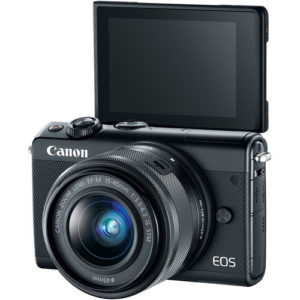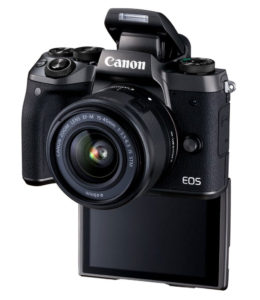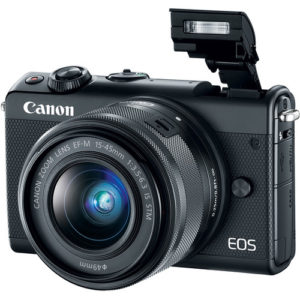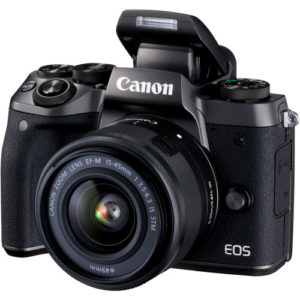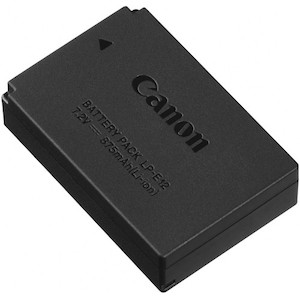There are currently seven models within the Canon EOS M range, four of which are still in production. At the top of the chain sits the EOS M5 flagship camera, which incorporates much of the latest technology from Canon and differentiates itself by being the sole model to include a built-in viewfinder. On the other is the newly announced EOS M100, an entry-level model for those interested in upgrading from the camera on their smart device to something more serious.
It isn’t every day that we compare a flagship camera to an entry-level product but in this case, it seemed justified in light of the number of specifications their share including a 24MP APS-C sensor, Dual Pixel CMOS AF with 80% phase detection coverage, the latest DIGIC 7 image processor, and Full HD video up to 60fps with digital stabilisation for video recording.
In this comparison preview, our goal is to uncover all the most important ways in which the M100 and M5 differ and even more important, whether the flagship camera is worth the extra money. Let’s get started!
Ethics statement: The information supplied in this article is based on official specifications, press releases and our personal experience with Canon cameras. If we get the chance to test the two cameras side-by-side, we will publish a full comparison with high resolution image samples. We were not asked to write anything about these cameras, nor were we provided with any sort of compensation. Within the article, there are affiliate links. If you decided to buy something after clicking the link, we will receive a small commission. To know more about our ethics, you can visit our full disclosure page. Thank you!
1. Design
The first difference concerns the design of the two M100 and M5.
Weighing 302g and measuring 108.2 x 67.1 x 35.1mm, the M100 is one of the smallest, lightest, and most compact models in the EOS M range.
The M5, being the flagship model, is more burly than its entry-level sibling, with a weight of 427g and dimensions of 115.6 x 89.2 x 60.6mm. That said, it remains a much more compact and portable solution than a DSLR or even many of the high-end mirrorless products from other brands, especially when paired with the 15-45mm kit lens or a small prime.
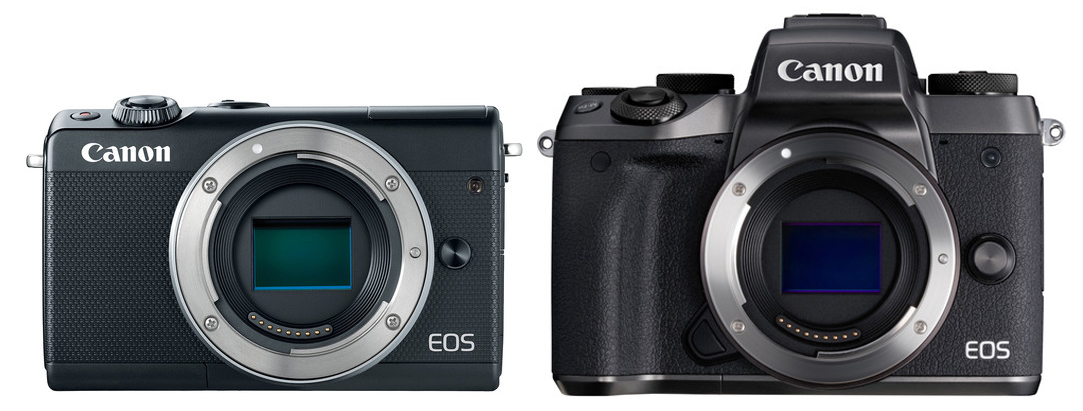
Two reasons for the larger dimensions of the M5 are the contoured grip, which gives you a better hold on the camera than the simple thumb rest of the M100, and the electronic viewfinder, which we’ll discuss in the next section.

Both cameras are constructed primarily from a strong polycarbonate composite.
Some features of the M5 you won’t find on the M100 are twin control dials for aperture and shutter speed, an exposure compensation dial (±3 EV), a mode dial, and 12 customisable buttons/dials around the body. The M100 has a single control dial flanked by a dial that allows you choose between stills/movies/Auto and customisable shutter/movie record buttons with four custom functions.
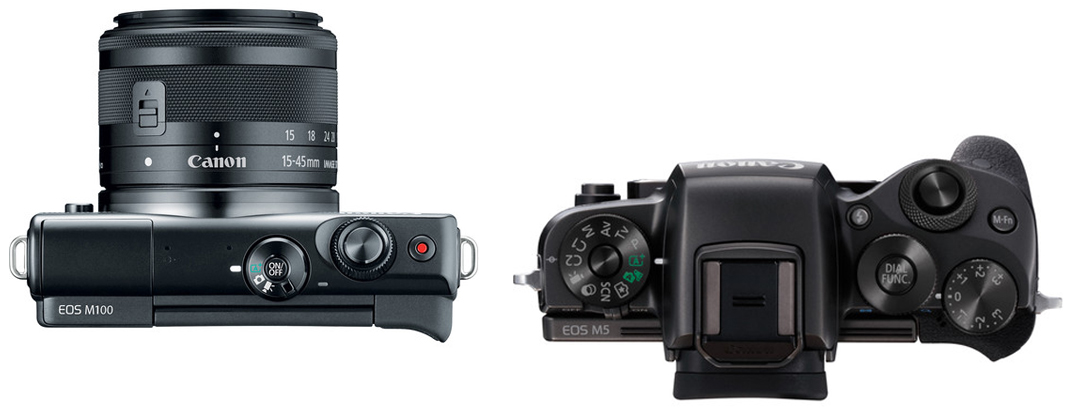
Both cameras sport a tilting touch sensitive LCD screen and built-in pop-up flash but only the M5 comes with a hot shoe for accessories such as an external flash unit.
Because it targets a more serious user base, the M5 is only available in black. The M100, by contrast, comes in black, silver and white and there is also the choice of seven colourful cases for the camera.
2. Built-In Electronic Viewfinder
The M5 is the only EOS M camera to feature a built-in electronic viewfinder. It is a 0.39-type with an OLED screen, 2,360K dots of resolution, a refresh rate of 120fps, 100% field coverage and an eye point of approximately 22mm.
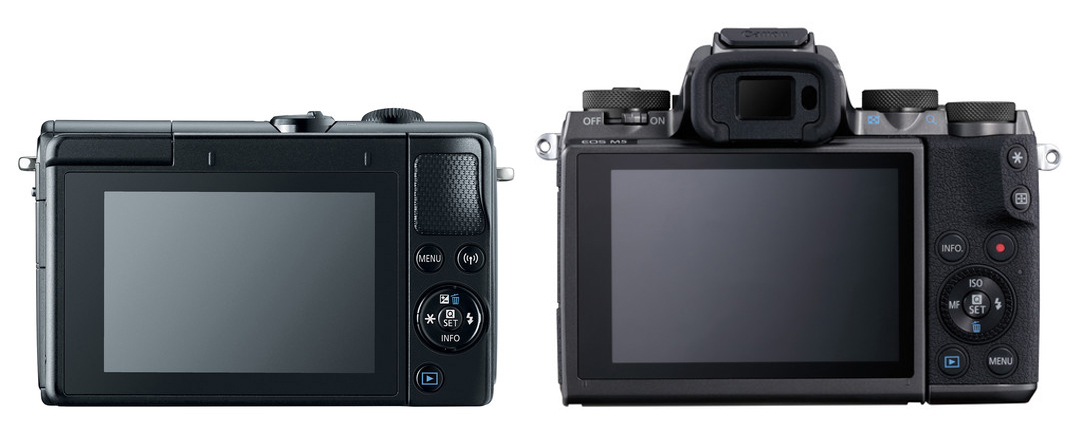
The M100 doesn’t feature a built-in electronic viewfinder and because it lacks a hot shoe, it can’t be used with an external viewfinder either. This may not bother you if you are accustomed to taking pictures with the screen of your smartphone or tablet however.
3. LCD Screen
Although both the M100 and M5 have a tilting LCD that is touch sensitive, their specifications aren’t identical.
The M5 has a larger 3.2-inch type with 1,620K dots of resolution while the M100 has a standard 3-inch type with 1,040K dots of resolution.
A second difference is that the screen of the M5 is tiltable 85° up and 180° down, whereas the M5’s is tiltable 180° up and 45° down.
4. Continuous Shooting and Buffer Depth
With fixed AF, the M5 can manage an average of 9 shots in a burst for up to 26 JPG frames. Switch to Servo AF and this drops to 7fps. (Note that Canon doesn’t provide any information about the RAW performance at either speed.)
The M100 can shoot as fast as 6.1fps for up to 89 JPG frames or 21 RAW frames with One-shot AF or 4fps for up to 1000 JPGs with Servo AF. (There is no information about the RAW performance at the slower speed.)
Long story short, although the M5 has better continuous shooting capabilities, the M100 appears to have a better buffer depth if the official specifications can be trusted.
5. 3-Axis vs 5-Axis Stabilisation
A tiny difference between the two cameras concerns digital stabilisation for video recording. Whereas the M5 uses 5-axis in-body digital stabilisation, the M100 only works on 3 axes with compatible lenses. On the M5, stabilisation is achieved by combining the optical stabilisation of select Canon lenses with digital stabilisation.
6. Flash Unit
Both cameras come with a built-in pop-up flash unit, albeit with slightly different specifications.
The first difference is that they are located in different points on the body. The M5’s is on top of the fake pentaprism that houses the electronic viewfinder while the M100’s is positioned on the top left.
Second is the recycle time: the M5’s flash only takes three seconds to recharge, while the M100’s takes five.
Finally, the M5 provides a Manual Flash On/Off option with three power output settings in addition to Auto (E-TTL II). On the M100, you are limited to Auto.
Both units offer a GN of 5 metres (ISO 100), red-eye reduction, a sync speed of 1/200s, exposure compensation of +/- 2 EV and second curtain synchronisation.
The presence of a hot shoe also makes it possible to use external EX series speed lights on the M5.
7. Smooth Skin Mode
The M100 has been designed to appeal to the selfie-taking generation, which is why Canon opted to give it a Smooth Skin feature that brightens the image in five different levels and smoothens your complexion.
This feature isn’t available on the M5 at the time of writing but who knows – it might just come to the camera via firmware update at some point in the future!
8. Battery Type
The M100 and M5 are both capable of taking an average of 295 shots on one battery charge (or just over 400 with the Eco mode) but they use different batteries to achieve this result.
The M5 accepts the larger LP-E17 battery whereas the M100 uses the LP-E12.
Both models are supplied with a battery charger but cannot be charged via USB.
Conclusion
Of all the points mentioned here, the one most likely to sway your opinion is the price, which is why we’ve saved it for the conclusion.
The current retail price of the M5 is around $1100 with the EF-M 15-45mm f/3.5-6.3 IS STM kit lens, which is substantially more than the M100 whose retail price is just short of $600.
In other words, you could almost buy a second camera with the money you’d save by choosing the M100.
The cost of the M5 is also difficult to justify because there are many similarly priced mirrorless models from other brands that sport advanced features that the M5 doesn’t have such as 4K video and 5-axis in-body sensor stabilisation.
Personally speaking, I feel the M100 is better value for the money since it comes furnished with many of the M5’s most important features such as the 24MP sensor and Dual Pixel CMOS AF system for around half the price. But if you have your heart set on a Canon mirrorless camera and can’t live without a built-in viewfinder, a more ergonomic design and extra controls, it’s the M5 or nothing.
Check price of the Canon EOS M100 on
Amazon | Amazon UK | B&H Photo | eBay
Check price of the Canon EOS M5 on
Amazon | Amazon UK | B&H Photo | eBay
You may also be interested in the following articles:

